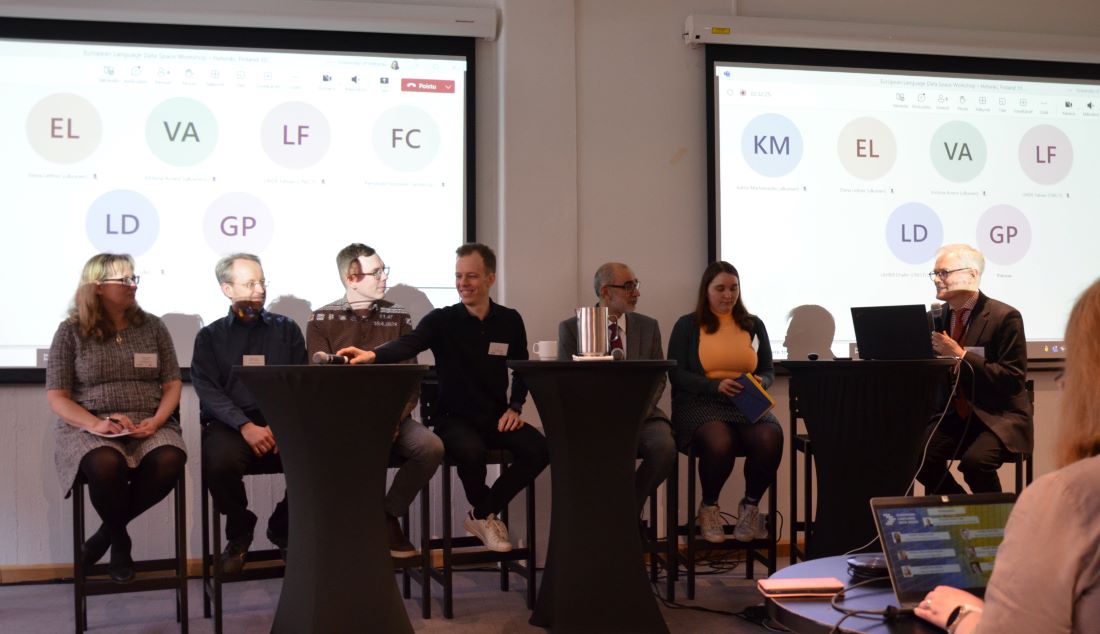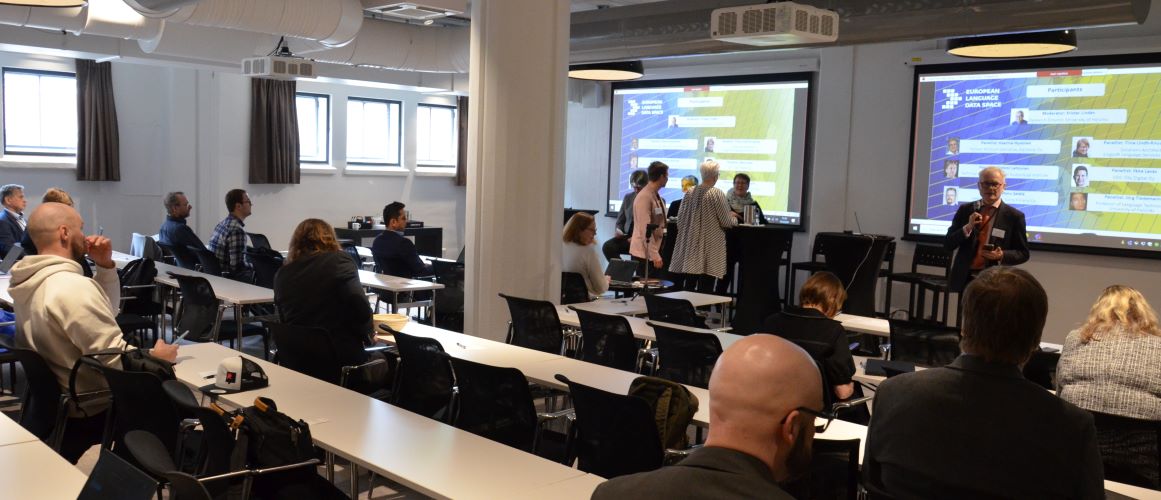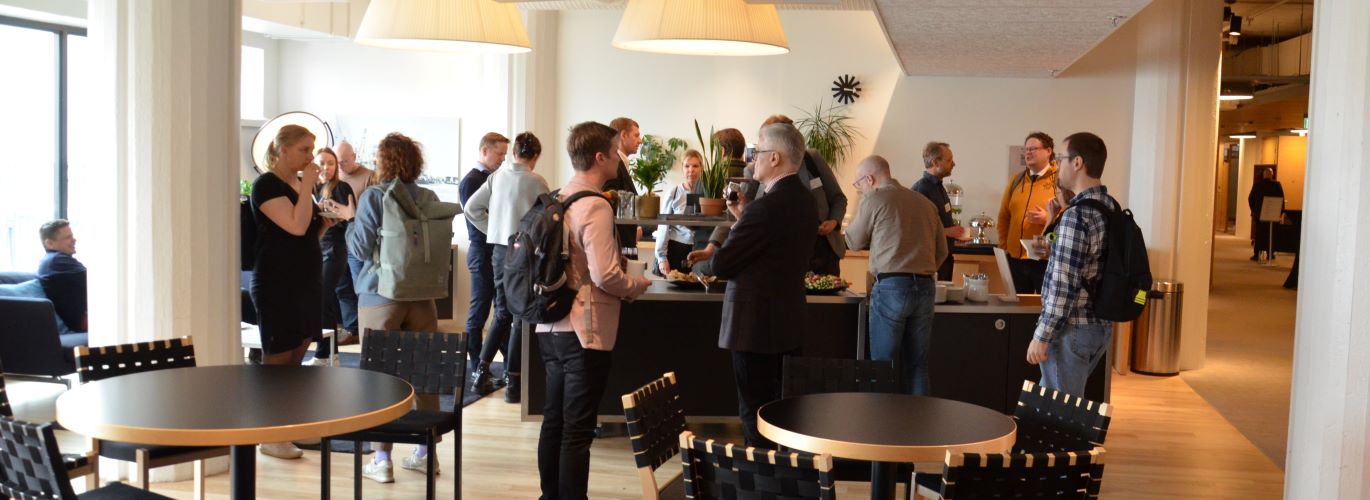


The EU is in the process of creating an internal market for all types of data. The aim is to ensure that data can be shared from one stakeholder to another within the region, in accordance with the EU legislation. Data sharing requires interactive networks – data spaces – that can connect data providers and users, and offer a platform for them to communicate, make contracts and trade with each other.
All the upcoming European data spaces will be developed in line with the European Data Strategy. There are development plans for data spaces for approximately 15 different strategic fields. According to the vision, data spaces will allow for the commercialisation and more efficient re-use of data. This will benefit not only commercial stakeholders in the EU, but also EU citizens by providing them with better digital services, for example. In addition, researchers could gain access to new types of data and materials, which could boost basic research and increase opportunities for product development and innovation.
The European Language Data Space (shortened: LDS) is an ecosystem for the sharing and commercialisation of language data, such as text and speech data, and for the development of large language models and language-centric Artificial Intelligence. The Language Data Space is being developed and coordinated by the LDS Consortium, which was established in early 2023 with the support of the European Commission. The first phase of the LDS will last three years and during this period, the technical and legal framework for the operation of the common language data platform will be established in cooperation with the various stakeholders.
The work on the language data space will also be driven forward by ALT-EDIC, the language technology alliance of EU member states established in early 2024. In particular, ALT-EDIC aims to ensure the development of EU-based large language models.
The Language Data Space will be built partly on top of existing networks and language technology infrastructures. Sitra’s publication Snapshot of Finnish data spaces (2024) summarises well the current situation in Finland with regard to language technologies and the Language Data Space (in Finnish).
In spring 2024, the LDS Consortium launched a series of country-specific workshops to share information about the possibilities of the common Language Data Space, and to reach as many stakeholders in each member country as possible. The workshops are organised in collaboration with local institutions. In April 2024, Finland had the honour of being the first EU member state to host an LDS workshop. The event was organised locally by the University of Helsinki. More information on workshops in other EU countries and upcoming LDS events can be found on the Language Data Space website.
The Finnish LDS workshop provided an opportunity for organisations and companies in Finland to exchange ideas on the possibilities and challenges that a common platform and marketplace for language models and data could offer. As remote presenters, the workshop featured Philippe Gelin from the European Commission, and Georg Rehm from DFKI in Germany. In the panel discussions (see photos below), partners from the LAREINA project coordinated by the University of Helsinki shared their views on the importance of language data and on the challenges regarding the availability and technical quality of data or regarding copyright constraints. Without access to electronic data of sufficient quality and scope, it is difficult to develop language models for speakers of small and medium-sized languages.
After the LDS workshop, Finland initiated the membership process to join ALT-EDIC as an observer member. After summer 2024, the full membership of Finland in ALT-EDIC was confirmed for the next three years. The administrative representative of Finland in ALT-EDIC is the Ministry of Transport and Communications, with whom the University of Helsinki aims to maintain an active dialogue.

Language Data Space invites European stakeholders to join the LDS User Group. The group includes commercial stakeholders from different sectors as well as representatives from both public administrations and research. The news from the remote meeting of the LDS User Group in November 2024 can be found here. Joining the LDS User Group is done via a form that can be found on the LDS website. In particular, language data providers and utilisers, as well as language model developers, are warmly welcome to join the group.
At the end of 2024, the Language Data Space is entering the pilot phase, where the Language Bank of Finland is also actively involved. The aim is to test the pilot version of the LDS platform in Finland and to collect user feedback. The Language Bank of Finland is also planning to organise a workshop in spring 2025 on the Language Data Space, ALT-EDIC and copyright issues. We will inform about this upcoming event on our website and through the LAREINA project.


All photos in the article: Jyrki Niemi / University of Helsinki
In case special protective measures are required in order to process your research data, you may consider using the Sensitive Data services available at CSC. The SD services can support you in processing your research data securely. SD Connect (for storing and sharing data) and SD Desktop (for processing and computing) provide a completely isolated work environment, available just for you and your colleagues.
Before starting a Sensitive Data project, make sure that you have carefully assessed the risks concerning your dataset. SD services should only be used when necessary, since the possibilities for processing the data within SD Desktop are intentionally limited.
Helmikuussa 2022 tehdyn Kielipankin yleisten ehtojen ja aineistokohtaisten käyttöehtojen päivityksen jälkeen kävi ilmi, että luvanvaraisia aineistoja koskeviin CLARIN RES -tyyppisiin lisensseihin kaivattiin vielä tarkennusta. 24.5.2022 alkaen RES-lisenssien uusi versio 2.1 alkaa seuraavalla tavalla (muuttuneet kohdat lihavoitu):
”Oikeudenhaltija myöntää Käyttäjälle henkilökohtaisen maksuttoman, ei-yksinomaisen ja pysyvän (tekijänoikeuden voimassaoloajan kestävän) oikeuden käyttää ja kopioida Aineistoa Käyttäjän kanssa sovittuun tarkoitukseen muutettuna, muuttamattomana tai osana yhteenliitettyä teosta. […]”
Luvanvaraisten aineistojen uudet käyttäjät hyväksyvät loppukäyttäjän lisenssin uusimman version ennen hakemuksen tekemistä Kielipankin oikeudet -palvelussa. Lisenssien muutoksista ilmoitetaan vielä erikseen sähköpostitse niille käyttäjille, joilla on ennestään Kielipankin oikeudet -palvelun kautta myönnetty pääsy yhteen tai useampaan rajoitettuun aineistoon.
Linkki yksittäisen aineiston lisenssiin löytyy Kielipankin aineistoluettelosta tai kyseisen aineistoversion kuvailutietueesta (ks. Documentation).
Kooste Kielipankin soveltamien loppukäyttäjän lisenssien sisällöstä, erilaisten lisäehtojen mahdollisista yhdistelmistä ja näissä äskettäin tapahtuneista muutoksista löytyy sivulta CLARIN-aineistojen loppukäyttäjän lisenssit.
After the general update of the Terms of Use of the Language Bank of Finland and the resource-specific end-user licenses that took place in February 2022, it turned out that a further clarification was required for CLARIN RES type licenses. Starting on 24th May 2022, the new version 2.1 of the RES license begins in the following way (here, the changes are bolded):
”The Rightholder grants the End-User a personal free, non-exclusive and perpetual (for the duration of the copyright) right to use and make copies of the Resource for the purpose agreed with the End-User as such, as modified, or as part of a compilation or derived work. […]”
New users of restricted resources must accept the end-user licenses before applying for access via Language Bank Rights. Those users who already have access to one or more restricted resources will be notified about license changes to the email address that was provided along with their application.
The link to the license of an individual resource can be found on the list of corpora in the Language Bank of Finland or via the metadata record (see Documentation) of the resource version in question.
Please see CLARIN End-User License Agreements (EULA) for an overview of the changes that have recently taken place in the end-user licenses applied by the Language Bank.
The Terms of Use of the Language Bank of Finland and the resource-specific license terms and conditions have been updated.
The Terms of Use of the Language Bank of Finland and the General Terms of Use for CSC’s Services for Research and Education are binding to all users of the Language Bank of Finland. In addition, the users are required to comply with the resource-specific terms and conditions.
Read the general terms as well as the resource-specific licenses carefully. The link to the license of a given resource is provided in the metadata record of the resource in question and on the list of resources of the Language Bank.
During the spring, the licenses of all resources that contain personal data will be supplemented with resource-specific data protection terms and conditions. In case you notice that the data protection terms and conditions have not yet been specified for the resource you are planning to use, please follow the guidelines for processing corpora stored in the Language Bank of Finland that contain personal data and contact the Language Bank in case you need further information regarding data protection.
Notifications about updates regarding the licenses of individual resources will be published on the Language Bank website as well as emailed to the users who have access to the resource on the basis of a separate application.
Kielipankin yleiset käyttöehdot on päivitetty. Samalla on täsmennetty myös aineistokohtaisia käyttöehtoja.
Kielipankin yleiset käyttöehdot sekä CSC:n tutkimuksen ja opetuksen palvelujen yleiset käyttöehdot sitovat kaikkia Kielipankin käyttäjiä. Lisäksi käyttäjien on noudatettava aineistokohtaisia ehtoja.
Tutustu yleisiin käyttöehtoihin ja jokaisen käyttämäsi aineiston käyttöehtoihin huolellisesti. Linkki yksittäisen aineiston lisenssiin löytyy kyseisen aineiston kuvailutietueesta ja Kielipankin verkkosivuilla olevasta aineistoluettelosta.
Henkilötietoja sisältävien aineistojen (PRIV-merkintä) lisensseihin lisätään kevään aikana aineistokohtaiset tietosuojaehdot. Jos tietosuojaehtoja ei jonkin käyttämäsi aineiston osalta vielä ole, noudata ohjeita henkilötietoja sisältävien Kielipankin aineistojen käsittelyyn ja pyydä tarvittaessa lisätietoja Kielipankista.
Aineistokohtaisten käyttöehtojen päivityksistä ilmoitamme jatkossa Kielipankin verkkosivuilla sekä sähköpostitse niille käyttäjille, jotka ovat saaneet erillisellä hakemuksella pääsyn aineistoon.
Kielipankin aineistokohtaisiin käyttöehtoihin on alkuvuoden 2022 aikana tulossa joitakin tarkennuksia ja täydennyksiä. Näkyvimpänä muutoksena ovat aineistokohtaiset tietosuojaehdot, jotka lisätään kaikkien henkilötietoja sisältävien aineistojen käyttöehtoihin uutena osiona. Ilmoitamme yksittäisten aineistojen käyttöehtoihin liittyvistä päivityksistä Kielipankin verkkosivuilla.
Kielipankissa oleva aineisto sisältää henkilötietoja, jos sen lisenssissä on merkintä +PRIV. Tällöin sitoudut käsittelemään aineiston sisältämiä henkilötietoja luottamuksellisesti, huolellisesti ja vain siihen käyttötarkoitukseen, jota varten olet saanut aineistoon pääsyn. Muut henkilötietojen käsittelyä koskevat rajoitukset kerrotaan aineistokohtaisissa tietosuojaehdoissa. Katso myös Kielipankin yleiset ohjeet henkilötietoja sisältävien aineistojen käsittelyyn.
Kun ryhdyt käyttämään Kielipankissa olevaa henkilötietoja sisältävää aineistoa uudessa hankkeessa tai uuteen tarkoitukseen, ilmoita hankkeesi lyhyt ja yleistajuinen otsikko sekä avoimesti saatavilla olevan tietosuojaselosteen linkki Kielipankille tällä lomakkeella. Julkaisemme antamasi tiedot Kielipankin verkkosivuilla, jolloin ne ovat kaikkien aineiston käytöstä kiinnostuneiden nähtävillä.
Muistathan tutustua jokaisen käyttämäsi aineiston käyttöehtoihin huolellisesti. Jos jokin käyttöehdoissa askarruttaa tai et löydä tässä vaiheessa kaikkia tarvitsemiasi tietoja, kysythän Kielipankista lisää.
In the Language Bank of Finland, a given resource may be available as several different versions or variants that are provided for different purposes. For instance, the resource may be offered as a downloadable version, but there may also be a variant that is searchable via Korp.
In order to make it more convenient for users to locate the corpus version they need, we started creating resource group pages that provide an overview of all the available versions of the resource in question. For instance, all the resource versions that are included in the Plenary Sessions of the Parliament of Finland (eduskunta) resource group can be found at https://www.kielipankki.fi/corpora/eduskunta/.
All the resources that are available via the Language Bank of Finland are listed on the Corpora page, https://www.kielipankki.fi/corpora/. For each individual resource version mentioned on the list, you can find links to the
When citing the resource, please refer to the specific resource version that was used. This will make your research easier to replicate.
Samasta aineistosta voi olla yhtä aikaa saatavilla useita erilaisia versioita, joista käyttäjä voi valita omiin tarkoituksiinsa sopivimman. Tietty aineisto voi esimerkiksi olla tarjolla sekä omalle koneelle ladattavana versiona että Korp-palvelun kautta tutkittavana versiona.
Jotta sopivan aineistoversion löytäminen kävisi helpommin, tietystä aineistosta tehdyt versiot ja muunnelmat on ryhdytty keräämään yhteen uusille aineistoryhmien tietosivuille. Esimerkiksi viimeisimmät Eduskunnan täysistunnot (eduskunta) -ryhmään kuuluvat aineistoversiot voi tarkistaa osoitteesta https://www.kielipankki.fi/aineistot/eduskunta/.
Kaikki Kielipankin kautta välitettävät aineistot on tuttuun tapaan lueteltu Kielipankin aineistosivulla, https://www.kielipankki.fi/aineistot/. Aineistosivulla olevassa taulukossa on linkit kunkin aineistoversion
Kun viittaat aineistoon, mainitsethan sen aineistoversion viitetiedot, jota olet käyttänyt. Näin tutkimuksesi on helpommin toistettavissa.
Ylen artikkelissa kerrotaan Lahjoita puhetta -kampanjan merkityksestä Suomelle ja suomen kielelle. Myös Kielipankki on mainittu!
Helsingin yliopiston uutispalstalla kerrotaan Lahjoita puhetta -kampanjasta, jossa myös Kielipankki on mukana. Mari Peltosen haastateltavina olivat Krister Lindén ja Mietta Lennes.
Did you know that the Language Bank of Finland offers reference instructions, including a persistent identifier, for each and every corpus version? You should include the reference in all publications where the corpus in question has been used.
Systematic citation practices make your study easier to replicate, and the corpus compilers can be recognized for their work.
Tiesitkö, että Kielipankki tarjoaa jokaiselle aineistolle ja sen eri versioille valmiin viittausohjeen, joihin sisältyy aineiston pysyvä tunniste? Tiedot kannattaa lisätä lähdeluetteloon kaikissa julkaisuissa, joissa kyseistä aineistoa on hyödynnetty.
Yhtenäinen viittaustapa helpottaa tutkimuksen toistamista. Samalla aineistojen koostajat saavat tunnustuksen työstään.
The Language Bank of Finland provides citation instructions for all corpus versions. The reference instructions are accessible from the Corpora list of the Language Bank of Finland (click on the double quotes ) and from the metadata of each corpus. On the reference instruction page, you can now also find a link to a Google Scholar query for publications related to the corpus in question.
The links to Google Scholar are generated automatically by the Language Bank of Finland. In the links, the persistent identifier (PID) and the title of the corpus are used as optional search criteria.
Persistent identifiers have been used by the Language Bank since the year 2014. A unique persistent identifier is included in the reference instructions for each corpus distributed via the Language Bank of Finland. The identifiers will allow for specific corpus versions (or at least information about their status) to be retrieved even if their access locations, tools and methods change in the future.
References to research data sets are equally relevant as references to other scientific sources. Accurate references will help other researchers replicate your study. In addition, both your publications and the data sets you used will gain more visibility.
Kielipankin kautta välitettävien aineistojen jokaisella eri versiolla on oma viittausohje. Aineistokohtaiset ohjeet löytyvät Kielipankin aineistoluettelosta lainausmerkkikuvakkeiden kohdalta sekä jokaisen aineistoversion kuvailutiedoista. Viittausmuodon yhteydessä tarjotaan nyt myös Google Scholar -hakulinkki, joilla voi etsiä kyseiseen aineistoon liittyviä julkaisuja.
Scholar-hakulinkit tuotetaan Kielipankissa automaattisesti. Linkissä käytetään vaihtoehtoisina hakukriteereinä aineiston pysyvää tunnistetta (persistent identifier, PID) sekä kuvailutietojen mukaista otsikkoa.
Kielipankki on käyttänyt pysyviä tunnisteita vuodesta 2014 alkaen. Pysyvä tunniste sisältyy jokaisen Kielipankin aineiston viittausohjeeseen. Tunnisteen avulla tietyn aineistoversion tiedot löytyvät myös jatkossa, vaikka aineiston sijainti ja välitystapa muuttuisivat.
Viittaaminen tutkimusaineistoihin on yhtä tärkeää kuin viittaaminen muihin tieteellisiin lähteisiin. Täsmällisten aineistoviitteiden avulla tutkimuksesi on varmemmin toistettavissa. Sekä tuottamasi julkaisut että niissä käyttämäsi aineistot saavat lisää näkyvyyttä.
Tutkimusaineistoihin viittaaminen on yhtä tärkeää kuin tieteellisiin julkaisuihin viittaaminen. Joko sinä osaat? Katso uudet ohjeet: https://www.kielipankki.fi/tuki/viittaa-kielipankkiin-ja-fin-clariniin/
Kielivaroihin on tärkeää viitata yhtenäisellä tavalla, jotta tutkimus olisi myöhemmin toistettavissa ja jotta aineistojen koostajat tai työkalujen kehittäjät saisivat tunnustuksen työstään.
Kun käytät Kielipankissa olevaa kielivaraa (aineistoa tai työkalua), noudata Kielipankin viittausohjeita. Näin käyttämäsi kielivaran tarkka versio tulee täsmällisesti mainituksi. Kielipankissa jokaisella kielivaraversiolla on yksilöllinen pysyvä tunniste, joka sisältyy aina viittausohjeeseen. Tunniste auttaa varmistamaan, että kielivara löytyy ja tutkimuksen toistaminen onnistuu myös tulevaisuudessa, vaikka aineiston tai työkalun sijainti muuttuisi.
Monien aineistojen tai työkalujen lisenssiehdoissa edellytetään käyttäjiltä viittaamista kyseiseen kielivaraan. Tällöin lisenssissä mainitaan lisäehto BY (Nimeä/Attribution). Asianmukainen viittaus vaaditaan kaikkien sellaisten kielivarojen osalta, jotka on lisensoitu joko akateemiseen käyttöön (CLARIN ACA) tai luvanvaraiseen käyttöön (CLARIN RES). Myös avoimesti lisensoidut kielivarat saattavat edellyttää viittaamista (esim. Creative Commons Nimeä tai muut avoimet lisenssit).
Viittaamalla Kielipankkiin ja sen tarjoamiin kielivaroihin autat FIN-CLARINia seuraamaan aineistojen ja palveluiden käyttöastetta ja tuet Kielipankin jatkuvuutta.
Yksittäisten aineistoversioiden viittausohjeet löytyvät helposti Kielipankin aineistotaulukosta lainausmerkkikuvakkeen kohdalta.
Viittausohje mainitaan myös kielivaran kuvailutiedoissa. Kaikkien Kielipankin kielivarojen kuvailutietueet tallennetaan META-SHARE-hakemistopalveluun. Tietyn kielivaran kuvailutietueeseen pääsee aina viittausohjeessa mainitulla pysyväistunnisteella tai Kielipankin aineistotaulukosta aineiston nimen kohdalta. Kuvailutietueessa linkki viittausohjeeseen löytyy yleensä osiosta Documentation. Joissakin tapauksissa viittausohje näkyy suoraan kuvailutietueen kentästä Attribution Details. Kuvailutiedoista löytyvät myös aineistokohtaisen lisenssin tiedot.
Korp-konkordanssipalvelun kautta tarjottavissa kieliaineistojen versioissa linkki viittausohjeeseen löytyy sekä korpusvalikossa näkyvästä aineiston tietoruudusta että konkordanssivälilehden oikeasta reunasta yksittäisten hakuosumien kohdalta. Tietoruudun saa näkyviin ohjaamalla osoittimen korpusvalikossa aineiston nimen kohdalle.
Jokaiseen Kielivaran latauspalvelun kautta tarjottavaan aineistoversioon sisältyy aina README-niminen tiedosto, jossa mainitaan ko. aineistoversion pysyvä tunniste.
Esimerkkinä kielivaran 1990- ja 2000-luvun suomalaisia aikakaus- ja sanomalehtiä -korpus, versio 2 viittausohje:
Helsingin yliopisto (2017). 1990- ja 2000-luvun suomalaisia aikakaus- ja sanomalehtiä -korpus, versio 2 [tekstikorpus]. Kielipankki. Saatavilla http://urn.fi/urn:nbn:fi:lb-2017091901
Aineistoviittauksia ja niiden muotoilua koskevat käytännöt saattavat vaihdella julkaisukohtaisesti. On hyvä joka tapauksessa pyrkiä mainitsemaan Kielipankin viittausohjeessa olevat tiedot. Kun kirjoitat artikkelia tai muuta tutkimusjulkaisua, tarkista julkaisun ohjeistuksesta, onko aineistolähteet tapana mainita kirjallisuusluettelon osana vai erillisessä listassa.
Jos haluat mainita Kielipankin palvelukokonaisuutena, käytä verkko-osoitetta www.kielipankki.fi.
FIN-CLARIN-konsortion esittely Kielipankin sivustolla: http://urn.fi/urn:nbn:fi:lb-2014120212
CLARIN ERICin ja CLARIN-palveluiden yleiset viittausohjeet löytyvät CLARINin usein esitettyjen kysymysten sivulta.
on nyt nähtävillä YouTubessa. Videossa esitellään Korpin perusnäkymä, yksinkertainen haku, tilastonäkymä ja sanakuva. Tutustu ja kokeile!
Videoon lisätään piakkoin suomen- ja englanninkielinen tekstitys ja lisää Korp-ohjevideoita on tulossa.
on nyt nähtävillä YouTubessa. Videossa neuvotaan mm. kuinka voit jäsentää suomenkielisen tekstin automaattisesti tai tunnistaa puhetta suomenkielisestä äänitiedostosta.
Tutustu ja kokeile!
Yhteiskuntatieteellisen tietoarkiston (FSD) julkaiseman Tietoarkisto-lehden tuoreimman numeron 1/2018 teemana ovat tutkimuksen infrastruktuurit. Mukana on myös Kielipankki-aiheinen artikkeli (s. 22-23). Lehden verkkoversiota pääsee lukemaan Yhteiskuntatieteellisen tietoarkiston sivuilta.


